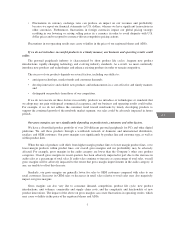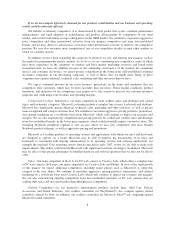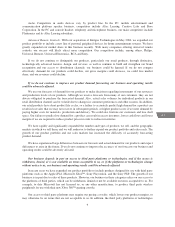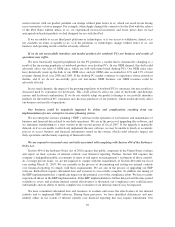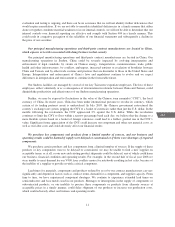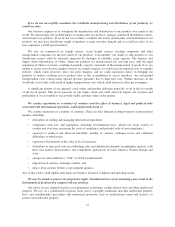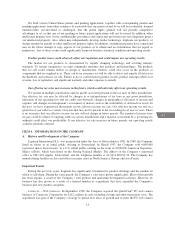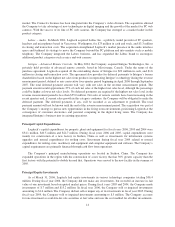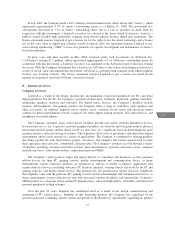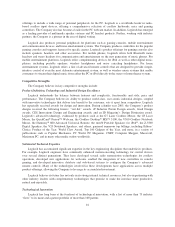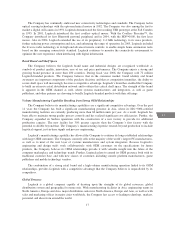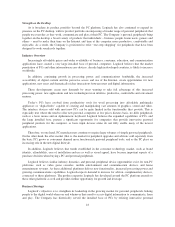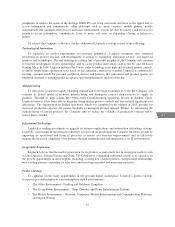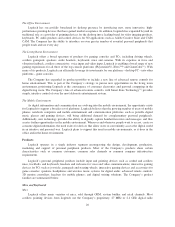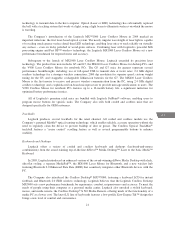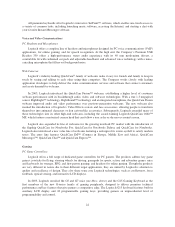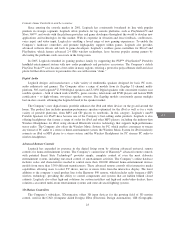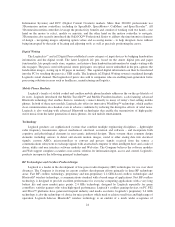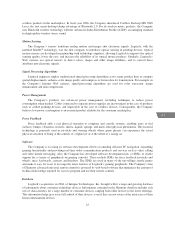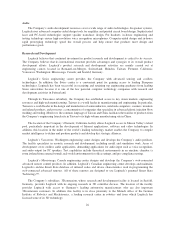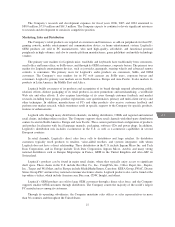Logitech 2006 Annual Report Download - page 75
Download and view the complete annual report
Please find page 75 of the 2006 Logitech annual report below. You can navigate through the pages in the report by either clicking on the pages listed below, or by using the keyword search tool below to find specific information within the annual report.
The Company has continually embraced new connectivity technologies and standards. The Company led in
optical sensing technology with the opto-mechanical mouse in 1982. The Company was also among the first to
market a digital still camera in 1991. Logitech demonstrated the first working USB prototype at the Fall Comdex
in 1995. In 2001, Logitech introduced the first cordless optical mouse. With the Cordless Presenter™, the
Company introduced its first Bluetooth personal peripheral and in 2004, with the MXTM1000, the first laser
mouse. Also in 2004, Logitech extended the use of its proprietary 2.4 GHz technology to its mice products,
further reducing power consumption and size, and enhancing the range of operation. In 2005, Logitech included
the Z-wave radio technology in its high end advanced remote controls, to enable simple home automation tasks
based on this emerging connectivity standard. Logitech continues to monitor the connectivity environment to
optimize the user experience when interfacing with digital information.
Retail Brand and Shelf Space
The Company believes the Logitech brand name and industrial designs are recognized worldwide as
symbols of product quality, innovation, ease of use and price performance. The Company enjoys a strong and
growing brand presence in more than 100 countries. During fiscal year 2006, the Company sold 72 million
Logitech-branded products. The Company believes that in the consumer market, brand identity and brand
awareness are important components of the purchase decision, and that as competition intensifies, the ability to
secure shelf space will increasingly become a competitive advantage. Logitech’s brand has enabled the Company
to build an extensive retail distribution network and to obtain this critical shelf space. The strength of this brand
is apparent in the OEM channel as well, where systems manufacturers and integrators, as well as game
publishers, and other partners are choosing to bundle Logitech-branded products with their offerings.
Volume Manufacturing Capability Resulting from Strong OEM Relationships
The Company believes its manufacturing capabilities are a significant competitive advantage. Over the past
11 years the Company has built a significant manufacturing presence in Asia, where its ISO 9000-certified
manufacturing facilities are currently producing more than 60 million units per year. As a result, Logitech has
been able to maintain strong quality process controls and has realized significant cost efficiencies. Further, the
Company expanded its Suzhou operations with the construction of a new factory to provide for additional
production capacity. The new facility has 30% greater capacity than the Company’s first factory with the
potential to double beyond that. The Company’s manufacturing expertise extends beyond production to include
logistical support, just-in-time supply and process engineering.
Logitech’s manufacturing capability has allowed the Company to continue its long-established relationships
with large OEM customers. The Company currently sells to the majority of the world’s largest PC manufacturers,
as well as to most of the next layer of systems manufacturers and system integrators. Because Logitech’s
engineering and design staffs work collaboratively with OEM customers on the specifications for future
products, the Company believes its OEM relationships provide it with valuable insight into the future of the
computer marketplace and technology trends. Further, Logitech plans to extend its OEM presence both with its
traditional customer base, and with new classes of customers including console platform manufacturers, game
publishers and mobile technology vendors.
The combination of a strong retail brand and a high-volume manufacturing operation linked to its OEM
relationships, provides Logitech with a competitive advantage that the Company believes is unparalleled by its
competitors.
Global Presence
Logitech is a global company capable of drawing upon the strengths of its global resources, global
distribution system and geographical revenue mix. With manufacturing facilities in Asia, engineering teams in
North America, Europe and Asia, major distribution centers in North America, Europe and Asia, as well as with
sales and marketing offices in major cities worldwide, the Company has access to leading technology, markets,
personnel and ideas from around the world.
17
CG
LISA


